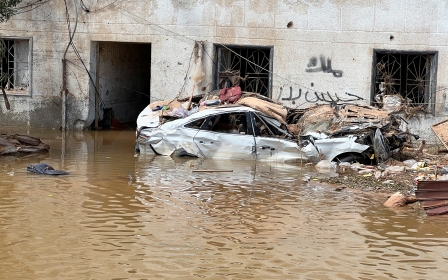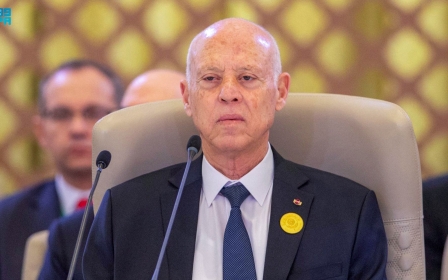Libya floods: A Turkish firm said it repaired Derna’s dam. But did it?

It is believed some 20,000 people were killed when Storm Daniel’s rains pummelled eastern Libya and caused two key dams outside the city of Derna to collapse last week.
According to various officials and reports, the structures were decrepit and had not been maintained or renovated for years.
The two dams, Abu Mansour and Derna, were originally built by a Yugoslav company in the 1970s using rocks and earth. They held back floodwaters in the valley that cuts through Derna until 1998, when the first cracks were observed.
An Italian consulting company assessed the cracks, concluding that the damage was significant and a third dam should be built to protect the city from flash flooding.
In 2007, Muammar Gaddafi, then ruler of Libya, hired Turkish contractor Arsel Construction Company to carry out the repair work and build a third dam.
New MEE newsletter: Jerusalem Dispatch
Sign up to get the latest insights and analysis on Israel-Palestine, alongside Turkey Unpacked and other MEE newsletters
The company’s website said work began on the Derna and Abu Mansour dams in 2007 and put the “completion date” as 28 November 2012, the year after the Libyan revolution that toppled Gaddafi. That website was taken down a few days after the Derna disaster.
According to Libya’s general prosecutor, al-Seqid al-Sour, the firm only began its work in October 2010 because of lack of funds, and stopped less than five months later because of the revolution. He said the work was never completed.
But what really happened?
Multiple explanations for the work not being completed (despite the Arsel website’s assertions) have been put forward.
One is that Arsel couldn’t finish the repairs because of lack of payment.
Abdul Hamid al-Dbaiba, prime minister of the Tripoli-based Libyan government that rivals the administration in Libya’s east where Derna lies, last week said the Turkish company’s project was cut short because it did “not provide the contracted budgets for the project”.
Another explanation could be the chaos that followed the revolution.
During the revolution Gaddafi claimed al-Qaeda had taken root in Derna. While that may not have been true, armed groups did take over the city.
“Construction vehicles were seized by militants, including trucks, cranes, cars,” a report from the London-based pan-Arab newspaper Al Arab said. “While Turkish engineers and workers were forced to return to their country.”
Attacked during uprising
A 2011 report in the Turkish newspaper Haberturk suggests Arsel’s construction sites were attacked during the uprising.
“We have six construction sites in the country. Four of them are in al-Marj, one is in Derna and one is in Benghazi. They raided the construction sites at 02.00 last night and destroyed them. But there is no harm in all of them,” Arsel's partner Mendost Dirlik told the daily at the time.
“We had a total of 1,700 employees, 300 of whom were Turkish. We gathered them all in a safe place in Benghazi. We will transport it to Turkey in groups. We have a loss of $5m. The state will compensate for this damage. The most pleasing part is that none of the workers had a nosebleed.”
According to the Al Arab report, Arsel tried to resume work in the city on condition that they recovered the looted vehicles, which the armed groups rejected.
Al Arab said the armed groups told the firm they were ready to cooperate only if the company’s management agreed to rent the vehicles to those who looted them, considering them spoils of war.
In 2014, the city fell into the hands of Islamic State group affiliates, further hindering the chance of work continuing.
As for the money, two funds worth $2m earmarked for the project were made available in 2012 and 2013 through bank credit. However, in a 2021 report the Libyan Audit Bureau criticised the water resources ministry for failing to close the fund appropriations after they had expired.
So what happened to the company?
Arsel, which was founded in 1989, began insolvency proceedings in February 2017. Even though the company has been declared bankrupt, its two shareholders sued Libya in 2020 in arbitration to collect more than a dozen allegedly unpaid contracts for work it said had done in the country.
A source familiar with the case said the Derna dam was not among the contracts that were brought to arbitration. It is not clear if that is because it received money for the dams contract or not.
Middle East Eye’s attempts to reach representatives of Arsel were unsuccessful. The address listed on its now-defunct website is now used by a psychiatrist.
Trade registry and court records indicate Arsel creditors are still seeking funds from the company as of 2023.
The source added that there was a legal question over whether Arsel shareholders could collect damages from Libya while the company is in insolvency.
This article is available in French on Middle East Eye French edition.
Editor’s note: Owners of the now defunct Arsel Construction Company contacted us through their lawyers to clarify that the date of completion mentioned in the company’s website was “the anticipated end date as stated in the contract.”
Middle East Eye delivers independent and unrivalled coverage and analysis of the Middle East, North Africa and beyond. To learn more about republishing this content and the associated fees, please fill out this form. More about MEE can be found here.






